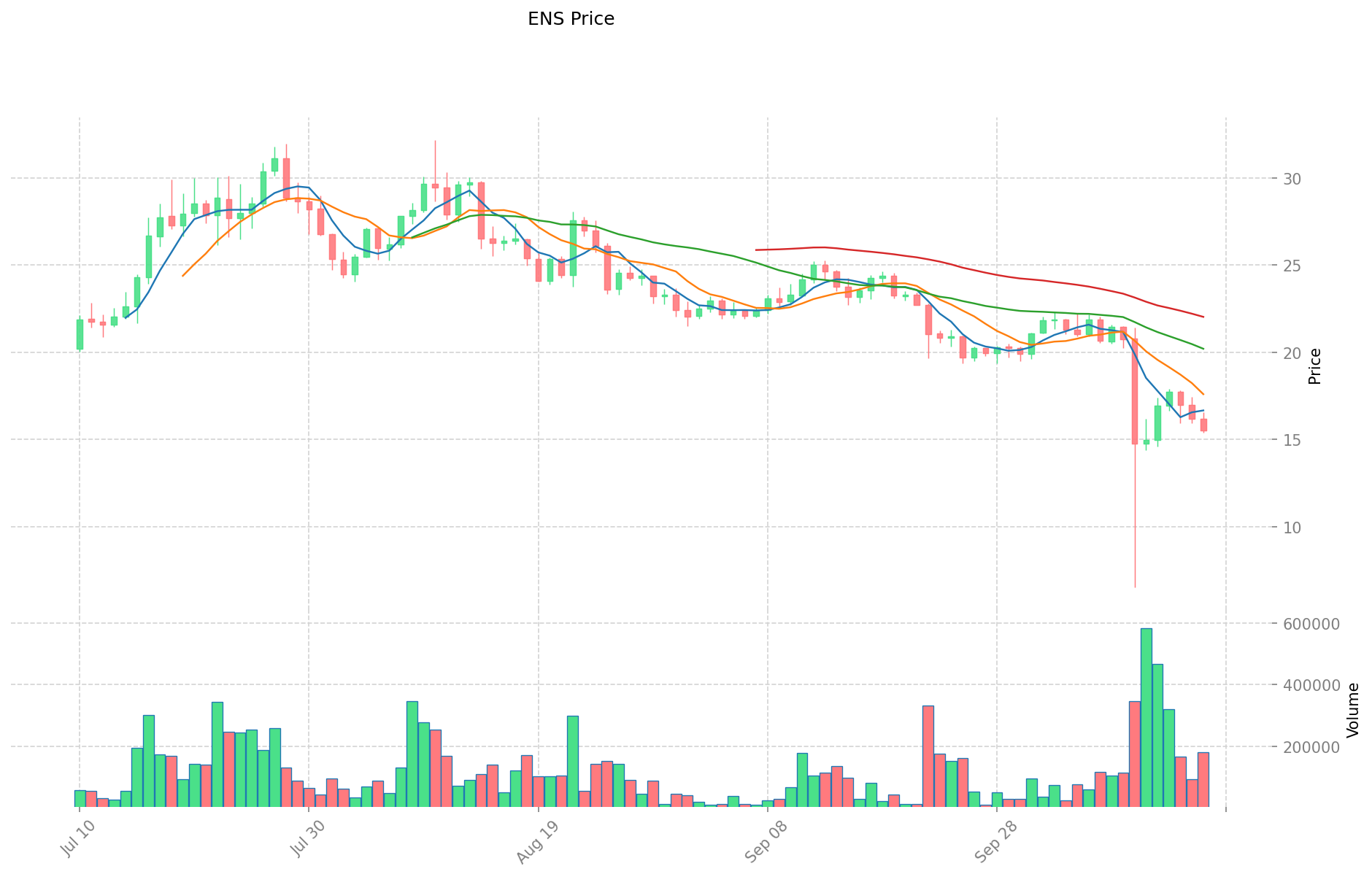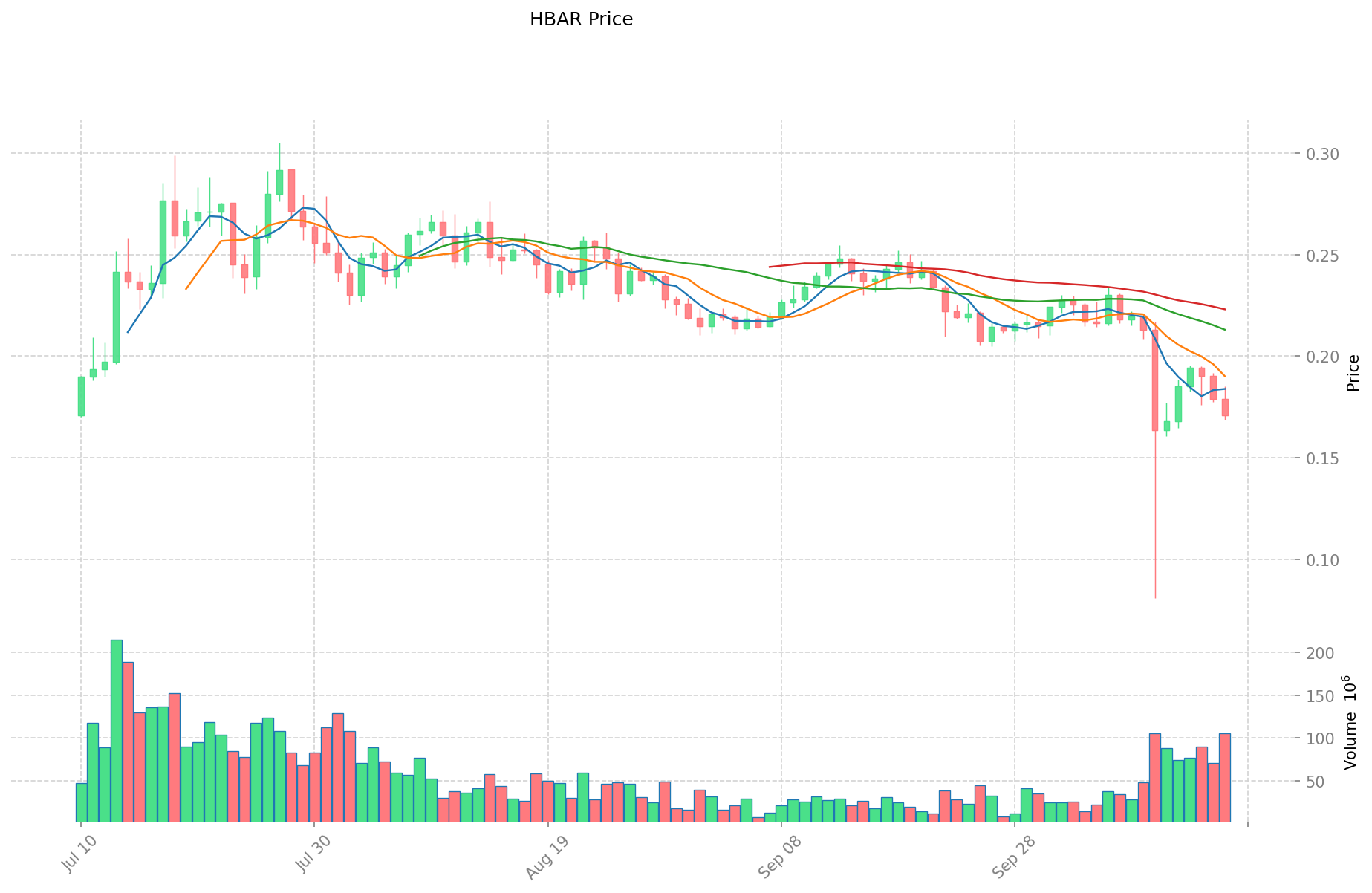ENS ve HBAR: Dijital Kimlik ve Yönetişim Alanında İki Yenilikçi Blockchain Çözümünün Karşılaştırılması


Giriş: ENS ve HBAR Yatırımı Karşılaştırması
Kripto para piyasasında, ENS ve HBAR arasındaki karşılaştırma yatırımcılar için daima gündemdeki bir başlıktır. Bu iki varlık, yalnızca piyasa değeri sıralamaları, kullanım alanları ve fiyat performansları bakımından değil; aynı zamanda kripto varlık pozisyonlamasında da önemli farklılıklar gösterir.
Ethereum Name Service (ENS): 2017’de piyasaya sürülen ENS, Ethereum blokzinciri tabanlı, dağıtık, açık ve genişletilebilir isimlendirme sistemiyle piyasa nezdinde güçlü bir kabul görmüştür.
Hedera (HBAR): 2018’de faaliyete geçen HBAR, hashgraph konsensüs mekanizmasını kullanan hızlı, güvenli ve adil bir halka açık defter ağı olarak öne çıkmış; yüksek işlem hacmi ve piyasa değeriyle küresel kripto piyasasında önemli bir konum elde etmiştir.
Bu makalede, ENS ve HBAR’ın yatırım değerleri kapsamlı biçimde incelenecek; tarihi fiyat trendleri, arz yapıları, kurumsal benimseme, teknolojik ekosistemler ile gelecek öngörüleri ele alınacak ve yatırımcıların en çok merak ettiği soruya yanıt aranacaktır:
"Hangisi şu an için daha avantajlı bir yatırım?"
I. Fiyat Geçmişi Karşılaştırması ve Güncel Piyasa Durumu
ENS ve HBAR Tarihi Fiyat Seyri
- 2021: ENS, token’ını airdrop yoluyla piyasaya sürdü; fiyatı 83,4 ABD doları ile tarihi zirvesini gördü.
- 2022: HBAR, kurumsal kullanımın artmasıyla ciddi bir yükseliş yaşadı ve 0,569229 ABD doları tepe değerine ulaştı.
- Karşılaştırmalı analiz: 2022 ayı piyasasında ENS, 83,4 ABD doları seviyesinden 6,69 ABD dolarına gerilerken, HBAR da 0,569229 ABD dolarından 0,00986111 ABD dolarına düştü.
Güncel Piyasa Durumu (17 Ekim 2025)
- ENS güncel fiyatı: 15,54 ABD doları
- HBAR güncel fiyatı: 0,17051 ABD doları
- 24 saatlik işlem hacmi: ENS 2.879.063 ABD doları, HBAR 18.552.719 ABD doları
- Piyasa Duyarlılık Endeksi (Korku & Açgözlülük Endeksi): 28 (Korku)
Gerçek zamanlı fiyatları görmek için tıklayın:
- ENS güncel fiyatı için Piyasa Fiyatı
- HBAR güncel fiyatı için Piyasa Fiyatı


Karşılaştırmalı Analiz: ENS ve HBAR Yatırım Değeri
I. ENS ve HBAR’a Genel Bakış
ENS (Ethereum Name Service), Ethereum blokzinciri üzerinde inşa edilen ve karmaşık cüzdan adreslerini kolayca hatırlanabilen “XXX.eth” formatına dönüştüren merkeziyetsiz alan adı sistemidir. HBAR ise Hedera platformunun yerel kripto varlığı olup, halka açık dağıtık defter teknolojisiyle çalışır.
II. ENS ve HBAR’ın Yatırım Değerini Etkileyen Temel Faktörler
Arz Mekanizması Karşılaştırması (Tokenomik)
- ENS: Arz, Ethereum alan adı kayıtları ve yönetişim yapısına bağlı olarak şekillenir
- HBAR: Önceden belirlenmiş bir arz programına göre kademeli token salınımı yapılır
- 📌 Tarihsel olarak: Arz yapısı, benimsenme dönemlerinde fiyat dalgalanmalarını tetikler.
Kurumsal Benimseme ve Piyasa Uygulamaları
- Kurumsal portföyler: İki varlık arasında kurumsal tercih hakkında sınırlı veri mevcut
- Kurumsal kullanım: ENS, Ethereum ekosistemi için temel alan adı altyapısı sunarken; HBAR, Hedera’nın kurumsal blockchain çözümlerinde rol alır
- Regülasyon yaklaşımı: İki token için de farklı ülkelerde farklı regülasyon yaklaşımları söz konusu
Teknik Gelişim ve Ekosistem İnşası
- ENS teknik güncellemeleri: Ethereum alan adı hizmetlerinin işlevselliğinde sürekli iyileştirmeler
- HBAR teknik gelişimi: Hedera’nın konsensüs mekanizması ve ağ kapasitesinde önemli yenilikler
- Ekosistem karşılaştırması: ENS, Ethereum’un DeFi ve NFT altyapısıyla entegre olurken; HBAR, kurumsal uygulama odaklıdır
Makroekonomik Etkenler ve Piyasa Döngüleri
- Enflasyon döneminde performans: Enflasyona karşı dirençle ilgili yeterli veri yok
- Para politikası etkisi: Faiz oranları ve ABD dolarının gücü, her iki varlığın değerlemesini etkiler
- Jeopolitik faktörler: Sınır ötesi işlem talebi ve uluslararası gelişmeler, benimseme hızını etkiler
III. 2025-2030 Fiyat Tahmini: ENS ve HBAR
Kısa Vadeli Tahmin (2025)
- ENS: Muhafazakâr 8,87 - 15,57 ABD doları | İyimser 15,57 - 22,57 ABD doları
- HBAR: Muhafazakâr 0,10 - 0,17 ABD doları | İyimser 0,17 - 0,24 ABD doları
Orta Vadeli Tahmin (2027)
- ENS, büyüme dönemine girebilir; fiyat aralığı 14,50 - 22,98 ABD doları öngörülmektedir
- HBAR, yükseliş trendine girebilir; fiyat aralığı 0,18 - 0,36 ABD doları olarak tahmin ediliyor
- Başlıca etkenler: Kurumsal sermaye girişleri, ETF gelişmeleri, ekosistem büyümesi
Uzun Vadeli Tahmin (2030)
- ENS: Temel senaryo 22,44 - 28,05 ABD doları | İyimser senaryo 28,05 - 34,23 ABD doları
- HBAR: Temel senaryo 0,26 - 0,43 ABD doları | İyimser senaryo 0,43 - 0,50 ABD doları
Uyarı: Bu tahminler, geçmiş veriler ve mevcut piyasa eğilimlerine dayanır. Kripto para piyasası yüksek oynaklığa sahip olup, hızla değişebilir. Bu bilgiler yatırım tavsiyesi olarak değerlendirilmemelidir.
ENS:
| 年份 | 预测最高价 | 预测平均价格 | 预测最低价 | 涨跌幅 |
|---|---|---|---|---|
| 2025 | 22.56925 | 15.565 | 8.87205 | 0 |
| 2026 | 25.5499475 | 19.067125 | 13.91900125 | 22 |
| 2027 | 22.9777923375 | 22.30853625 | 14.5005485625 | 43 |
| 2028 | 24.907480723125 | 22.64316429375 | 14.944488433875 | 45 |
| 2029 | 32.334438611475 | 23.7753225084375 | 16.404972530821875 | 53 |
| 2030 | 34.226954283146625 | 28.05488055995625 | 22.443904447965 | 80 |
HBAR:
| 年份 | 预测最高价 | 预测平均价格 | 预测最低价 | 涨跌幅 |
|---|---|---|---|---|
| 2025 | 0.23933 | 0.17095 | 0.095732 | 0 |
| 2026 | 0.2810418 | 0.20514 | 0.143598 | 20 |
| 2027 | 0.362205441 | 0.2430909 | 0.182318175 | 42 |
| 2028 | 0.420680956995 | 0.3026481705 | 0.281462798565 | 77 |
| 2029 | 0.4918638066966 | 0.3616645637475 | 0.3327313986477 | 112 |
| 2030 | 0.495046454857578 | 0.42676418522205 | 0.264593794837671 | 150 |
IV. Yatırım Stratejisi Karşılaştırması: ENS ve HBAR
Uzun Vadeli ve Kısa Vadeli Yatırım Yaklaşımları
- ENS: Ethereum ekosisteminin büyümesi ve alan adı benimsenmesine odaklanan yatırımcılar için uygundur
- HBAR: Kurumsal blokzincir çözümleri ve dağıtık defter teknolojisiyle ilgilenenler için idealdir
Risk Yönetimi ve Varlık Dağılımı
- Muhafazakâr yatırımcılar: %30 ENS, %70 HBAR dağılımı
- Agresif yatırımcılar: %60 ENS, %40 HBAR dağılımı
- Koruma araçları: Stablecoin tahsisi, opsiyonlar ve çapraz döviz portföyleri
V. Potansiyel Risk Karşılaştırması
Piyasa Riski
- ENS: Ethereum ekosisteminin performansı ve benimsenmesine yüksek derecede bağlıdır
- HBAR: Diğer kurumsal blokzincir çözümlerinden gelen rekabetten etkilenebilir
Teknik Risk
- ENS: Ethereum ağının ölçeklenebilirliği, alan adı sistemi güvenlik açıkları
- HBAR: Ağ istikrarı ve hashgraph konsensüsündeki olası güvenlik zafiyetleri
Regülasyon Riski
- Küresel regülasyonlar, iki varlık üzerinde farklı etkiler gösterebilir; ENS, alan adı regülasyonundan, HBAR ise kurumsal benimseme engellerinden etkilenebilir
VI. Sonuç: Hangi Yatırım Daha Avantajlı?
📌 Yatırım Değeri Özeti:
- ENS avantajları: Ethereum ekosistemiyle güçlü entegrasyon, Web3 alan hizmetlerinde artan adaptasyon
- HBAR avantajları: Kurumsal odaklı blokzincir çözümü, farklı sektörlerde yaygın kullanım potansiyeli
✅ Yatırım Tavsiyesi:
- Yeni yatırımcılar: Kurumsal odak nedeniyle HBAR’a hafif ağırlık vererek dengeli portföy önerilir
- Deneyimli yatırımcılar: Piyasa trendleri ve ekosistem gelişmelerine göre dinamik portföy dağılımı uygulanabilir
- Kurumsal yatırımcılar: Her iki token’ın ekosistem potansiyelini analiz ederek uzun vadeli blokzincir stratejileriyle uyumlu yol haritası oluşturmalı
⚠️ Risk Uyarısı: Kripto para piyasası son derece oynaktır. Bu makale yatırım tavsiyesi içermez. None
VII. Sıkça Sorulan Sorular
S1: ENS ile HBAR arasındaki asıl farklar nelerdir? C: ENS, Ethereum üzerinde çalışan merkeziyetsiz bir alan adı sistemidir; HBAR ise Hedera’nın yerel kripto varlığıdır ve halka açık dağıtık defter teknolojisiyle işlem görür. ENS ağırlıkla Ethereum ekosistemine hizmet ederken, HBAR kurumsal blockchain çözümlerini hedefler.
S2: Hangisi tarihsel olarak daha iyi fiyat performansı gösterdi? C: Her iki token da yüksek volatilite yaşadı. ENS, 2021’de 83,4 ABD dolarıyla zirve yaptı; HBAR ise 2022’de 0,569229 ABD dolarına ulaştı. 2022 ayı piyasasında ENS, tepe değerinden HBAR’a göre daha sert bir düşüş yaşadı.
S3: ENS ile HBAR’ın arz mekanizmaları arasındaki temel fark nedir? C: ENS’in arzı, Ethereum alan adı kayıtları ve yönetişim modeline bağlıdır. HBAR ise önceden belirlenmiş bir arz planı ile kademeli olarak piyasaya sürülür.
S4: ENS ve HBAR’ın yatırım değerini etkileyen ana etkenler nelerdir? C: Arz yapısı, kurumsal benimseme, piyasa uygulamaları, teknik gelişim, ekosistem inşası ve enflasyon ile para politikası gibi makroekonomik faktörler başlıca etkenlerdir.
S5: 2030 için ENS ve HBAR’ın uzun vadeli fiyat tahminleri nedir? C: ENS için temel senaryo 22,44 - 28,05 ABD doları, iyimser senaryo ise 28,05 - 34,23 ABD dolarıdır. HBAR için temel senaryo 0,26 - 0,43 ABD doları, iyimser senaryo 0,43 - 0,50 ABD dolarıdır.
S6: Yatırımcılar portföylerini ENS ve HBAR arasında nasıl dağıtmalı? C: Muhafazakâr yatırımcılar için %30 ENS, %70 HBAR; agresif yatırımcılar için %60 ENS, %40 HBAR önerilir. Ancak, portföy dağılımı bireysel risk iştahına ve yatırım hedeflerine göre yapılmalıdır.
S7: ENS ve HBAR yatırımlarındaki başlıca riskler nelerdir? C: Önemli riskler arasında piyasa oynaklığı, teknik sorunlar (ENS için ölçeklenebilirlik ve güvenlik, HBAR için ağ istikrarı ve hashgraph güvenliği) ve her iki varlık üzerinde farklılaşabilecek regülasyon belirsizliği yer alır.

RAD ve ETC: Modern finansal piyasalarda iki ticaret mekanizmasının karşılaştırmalı analizi

STOS ve ETH: Kurumsal Sektörde Blockchain Üstünlüğü Yarışı

Hedera (HBAR) 2025 Fiyat Analizi ve Yatırım Olanakları

Sei Network 2025 Gelişim Durumu ve Yatırım Fırsatı Analizi

2025'te SEI Ekosisteminin Gelişim Durumu ve Yatırım Fırsatlarının Analizi

Sui Fiyat Pazar Analizi ve 2025'te Uzun Vadeli Yatırım Potansiyeli

Bitcoin fiyatı pound cinsinden, traderların şimdi bilmesi gerekenler.

Kripto para piyasasında Pivot Noktası ticaret stratejilerini ustalıkla kullanmak

Yeni Madenciler İçin En İyi Kripto Madencilik Platformları

Blockchain’de Kriptografik Hashleme’nin Temelleri: Kapsamlı Bir Rehber

Ethereum fiyatı düşüşte, bu uzun vadeli long aç fırsatı olabilir.





